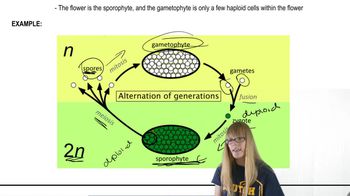How was Mendel able to derive postulates concerning the behavior of 'unit factors' during gamete formation when he could not directly observe them?
Table of contents
- 1. Introduction to Genetics51m
- 2. Mendel's Laws of Inheritance3h 37m
- 3. Extensions to Mendelian Inheritance2h 41m
- 4. Genetic Mapping and Linkage2h 28m
- 5. Genetics of Bacteria and Viruses1h 21m
- 6. Chromosomal Variation1h 48m
- 7. DNA and Chromosome Structure56m
- 8. DNA Replication1h 10m
- 9. Mitosis and Meiosis1h 34m
- 10. Transcription1h 0m
- 11. Translation58m
- 12. Gene Regulation in Prokaryotes1h 19m
- 13. Gene Regulation in Eukaryotes44m
- 14. Genetic Control of Development44m
- 15. Genomes and Genomics1h 50m
- 16. Transposable Elements47m
- 17. Mutation, Repair, and Recombination1h 6m
- 18. Molecular Genetic Tools19m
- 19. Cancer Genetics29m
- 20. Quantitative Genetics1h 26m
- 21. Population Genetics50m
- 22. Evolutionary Genetics29m
2. Mendel's Laws of Inheritance
Mendel's Experiments and Laws
Problem 1d
Textbook Question
Give the information requested.
The gametes produced by an organism with the genotype Rt/rT
 Verified step by step guidance
Verified step by step guidance1
Step 1: Understand the genotype Rt/rT. This represents a heterozygous organism where the alleles for two genes (R and T) are located on homologous chromosomes. The slash (/) separates the alleles on the two homologous chromosomes. One chromosome has the alleles R and t, while the other has r and T.
Step 2: Draw a diagram of the homologous chromosomes. On one chromosome, place the alleles R and t in the order given. On the homologous chromosome, place the alleles r and T in the same order. This will visually represent the genotype Rt/rT.
Step 3: Recall the concept of independent assortment and crossing over. During gamete formation (meiosis), homologous chromosomes can segregate independently, and crossing over can occur between them, leading to different combinations of alleles in the gametes.
Step 4: Determine the possible gametes. Without crossing over, the organism can produce two types of gametes: Rt and rT. If crossing over occurs between the genes, recombinant gametes (RT and rt) can also be produced. Thus, the possible gametes are Rt, rT, RT, and rt.
Step 5: Summarize the results. The organism with the genotype Rt/rT can produce four types of gametes: Rt, rT, RT, and rt. The proportions of these gametes depend on the frequency of crossing over between the R and T loci, which is influenced by their physical distance on the chromosome.
 Verified video answer for a similar problem:
Verified video answer for a similar problem:This video solution was recommended by our tutors as helpful for the problem above
Video duration:
2mPlay a video:
Was this helpful?
Key Concepts
Here are the essential concepts you must grasp in order to answer the question correctly.
Homologous Chromosomes
Homologous chromosomes are pairs of chromosomes in a diploid organism that have the same structure and gene sequence but may carry different alleles. Each parent contributes one chromosome to the pair, resulting in genetic variation. Understanding homologous chromosomes is essential for visualizing how alleles are arranged and inherited during gamete formation.
Recommended video:
Guided course

Chromosome Structure
Alleles
Alleles are different versions of a gene that can exist at a specific locus on a chromosome. In the context of the genotype Rt/rT, 'R' and 'r' represent different alleles for one gene, while 't' and 'T' represent different alleles for another gene. The combination of these alleles determines the organism's traits and is crucial for understanding genetic variation and inheritance patterns.
Recommended video:
Guided course

New Alleles and Migration
Gamete Formation
Gamete formation, or gametogenesis, is the process by which diploid cells undergo meiosis to produce haploid gametes. During this process, alleles segregate so that each gamete receives one allele from each gene pair. For the genotype Rt/rT, the possible gametes produced would reflect the combinations of these alleles, which is key to predicting offspring genotypes in genetic crosses.
Recommended video:
Guided course

Formation of Plant Gametes
Related Videos
Related Practice
Textbook Question
404
views


